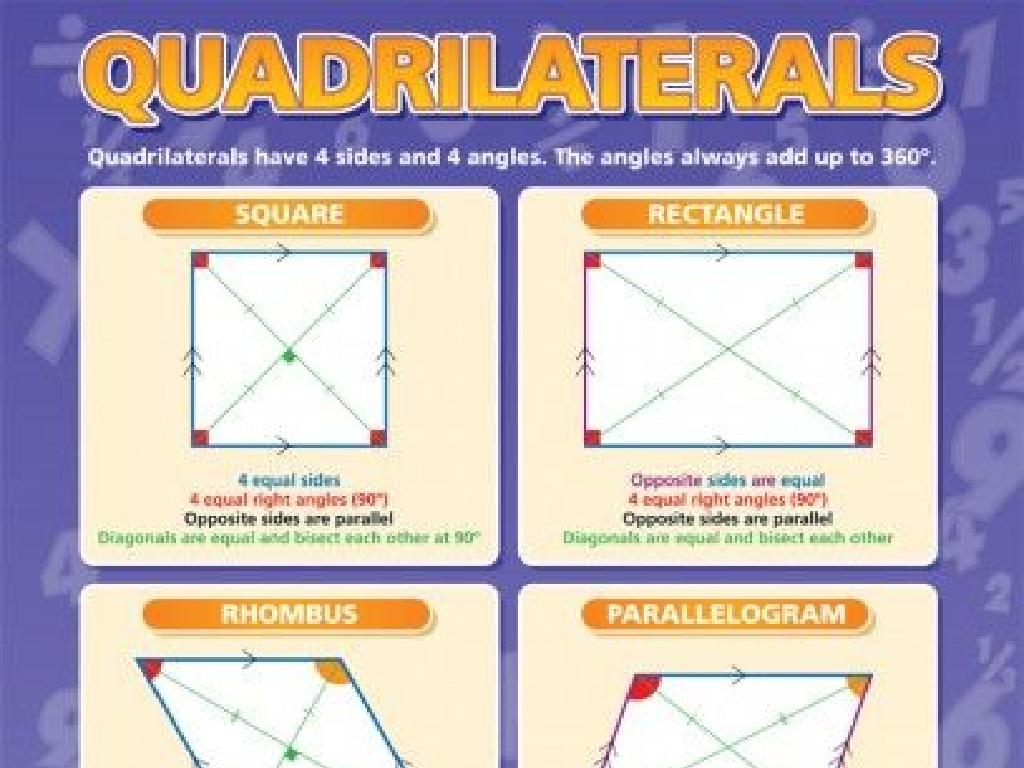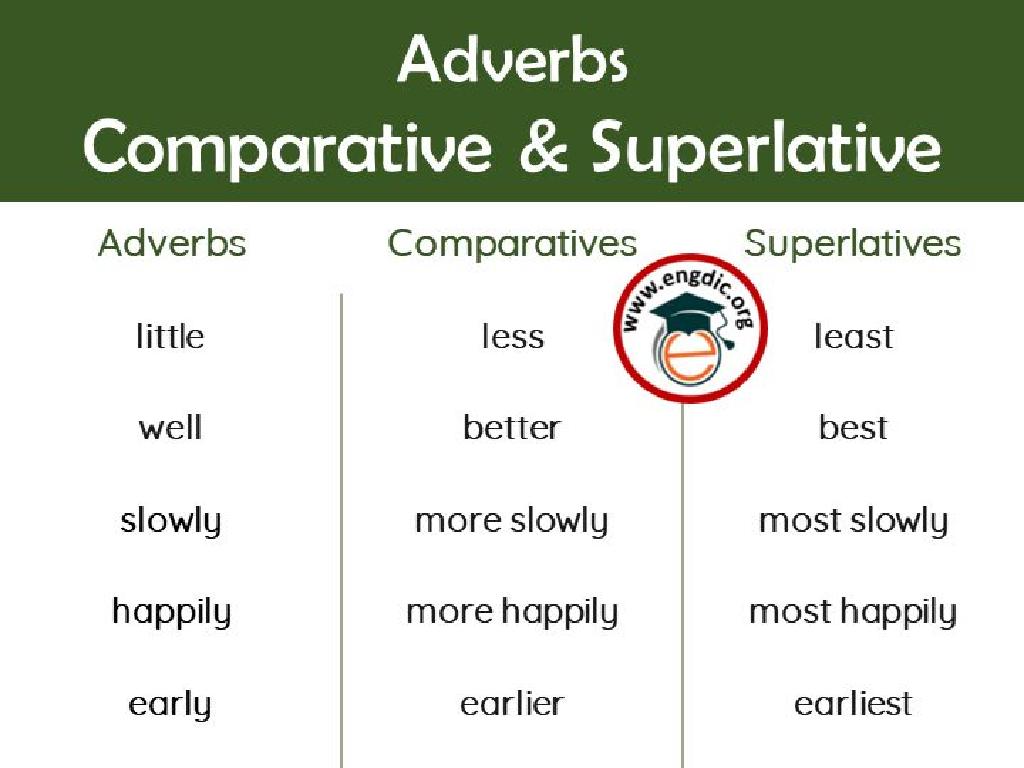Which Sentence Matches The Definition?
Subject: Language arts
Grade: Eighth grade
Topic: Homophones
Please LOG IN to download the presentation. Access is available to registered users only.
View More Content
Exploring Homophones in English
– Defining homophones
– Words pronounced alike but differ in meaning/spelling e.g., ‘to, two, too’
– Homophones: Same sound, different meaning
– ‘Their’ (belonging to them) vs. ‘there’ (in that place) vs. ‘they’re’ (they are)
– Common English homophones
– ‘Flour’ (ingredient) vs. ‘flower’ (plant); ‘knight’ (warrior) vs. ‘night’ (dark time)
– Contextual usage of homophones
– Use sentences to determine correct homophones: ‘The knight rides at night’
|
This slide introduces students to the concept of homophones, which are words that sound the same but have different meanings and often different spellings. Understanding homophones is crucial for mastering the complexities of English language and avoiding common errors in writing. Provide examples of homophones and engage students with exercises where they choose the correct word based on context. Encourage students to create sentences using homophones to demonstrate their understanding. This will help them remember the differences and uses of these tricky words.
Understanding Homophones
– What are homophones?
– Words that sound alike but have different meanings/spellings, e.g., ‘to, two, too’.
– Why homophones are tricky
– They can change the meaning of a sentence if misused.
– Context is key for homophones
– The surrounding words help determine the correct homophone.
– Practice with examples
– We’ll look at sentences to choose the right homophones.
|
This slide introduces the concept of homophones to the students, emphasizing their unique nature and potential for confusion in language. It’s crucial to explain that while homophones may sound the same, their meanings and spellings are distinct, which can lead to misunderstandings if not properly identified. The slide also highlights the importance of context in deciphering the correct meaning of homophones within a sentence. To reinforce learning, provide students with examples of homophones and encourage them to practice by creating sentences that illustrate the different meanings. This will help them grasp the concept and improve their ability to communicate effectively.
Homophones: Pair vs. Pear, Flour vs. Flower, Son vs. Sun
– ‘Pair’ and ‘Pear’ usage
– ‘Pair’ means two items, ‘Pear’ is a fruit.
– ‘Flour’ and ‘Flower’ distinction
– ‘Flour’ is for baking, ‘Flower’ is a plant.
– ‘Son’ versus ‘Sun’ context
– ‘Son’ is a male child, ‘Sun’ is the star.
– Practice with sentences
|
This slide introduces students to common homophones, which are words that sound the same but have different meanings and spellings. ‘Pair’ refers to a set of two things, while ‘Pear’ is a type of fruit. ‘Flour’ is a cooking ingredient, and ‘Flower’ is a blooming plant. ‘Son’ is a term for a male offspring, whereas ‘Sun’ is the celestial body that provides us with light and warmth. Encourage students to create sentences that correctly use these homophones to reinforce their understanding. For example, ‘I bought a pair of shoes,’ and ‘I ate a juicy pear.’ This exercise will help students distinguish between these words in writing and enhance their vocabulary skills.
Homophones in Sentences
– Identify homophones in sentences
– Homophones are words that sound alike but have different meanings, like ‘to’, ‘two’, and ‘too’.
– Understand homophones’ impact on meaning
– The sentence ‘They’re going to the park’ changes meaning if ‘to’ is replaced with ‘two’.
– Contextual usage of homophones
– Using homophones correctly is crucial for clear communication.
– Examples of homophones altering sentences
– ‘Their team won the game.’ vs. ‘There team won the game.’ Only one is correct.
|
This slide aims to help students recognize and understand homophones within the context of sentences. Emphasize that homophones can significantly alter the meaning of a sentence if used incorrectly. Provide examples to illustrate how the misuse of homophones can lead to confusion. Encourage students to think critically about word choice and to use context clues to determine the correct homophone in a given sentence. Activities can include rewriting sentences with the correct homophones, creating sentences using lists of homophones, and peer review exercises where students identify and correct homophone errors in each other’s work.
Homophones: Matching Definitions
– Exercise: Match sentence to definition
– Understand homophones in context
– Homophones sound the same but have different meanings and spellings.
– Example: Knight vs. Night
– ‘The knight rode through the night.’ – Which ‘night/knight’ refers to a time of day?
– Analyze sentences for correct usage
– Look for clues in the sentence to determine the right homophone.
|
This slide introduces an exercise aimed at helping students understand homophones words that sound the same but have different meanings and spellings. The example provided will guide students on how to approach the exercise. They should analyze the context in which the homophones are used to determine their correct application. Encourage students to discuss why ‘knight’ (a medieval soldier) or ‘night’ (the time of day) is the correct word based on the sentence’s meaning. This activity will enhance their vocabulary and spelling skills, which are crucial for effective communication.
Practice Time: Crafting Sentences with Homophones
– Understand homophones
– Homophones are words that sound alike but have different meanings, like ‘to’ and ‘too’.
– Class activity: sentence creation
– Create your own sentences using pairs of homophones.
– Use homophones correctly
– Ensure each homophone is used in the correct context.
– Share and discuss sentences
|
This slide is designed for a class activity focused on homophones. Begin by reviewing the definition of homophones and providing examples. Then, instruct students to create their own sentences using homophones, ensuring they understand the different meanings and correct usage. Students should write sentences that clearly demonstrate the meaning of each homophone. After the activity, have students share their sentences with the class and discuss any common mistakes or interesting uses. This will help reinforce their understanding of homophones and how they can be used in context. Possible activities: 1) Pair students to write a short story using homophones, 2) Homophone charades, 3) Create a homophone crossword puzzle, 4) Illustrate sentences to show the different meanings of homophones.
Class Activity: Homophone Hunt
– Find homophone pairs around you
– Write correct sentences for each
– Use each homophone in a way that shows its meaning clearly
– Share your sentences with peers
– Reflect on the homophone usage
– Think about how the homophones sound the same but have different meanings
|
This activity is designed to engage students with homophones in a practical and interactive way. Encourage students to look for homophones in their environment, such as ‘pair’ and ‘pear’ or in their reading materials. Once they find a pair, they should write a sentence for each word, demonstrating the correct usage based on the context. After writing their sentences, students will share them with the class, which will help reinforce their understanding and provide an opportunity for peer learning. As a teacher, be prepared to offer guidance and correct misunderstandings. Possible variations of the activity could include creating a homophone scavenger hunt, illustrating homophones with drawings, or composing a short story using multiple sets of homophones.
Homophones: Conclusion & Homework
– Recap: Why homophones matter
– Homework: Craft a short story
– Use creativity to write an engaging tale
– Include 10 different homophones
– Ensure each homophone is used correctly
– Share your story next class
|
As we wrap up today’s lesson on homophones, it’s crucial to emphasize their importance in the English language for clear communication. For homework, students are tasked with writing a short story that cleverly incorporates at least ten different homophones, demonstrating their understanding of how these words can be used in context. This activity will help reinforce their ability to distinguish between homophones and use them correctly. In the next class, students will have the opportunity to share their stories, which will not only enhance their writing skills but also their public speaking and listening skills as they hear how their peers have utilized homophones in different contexts.






